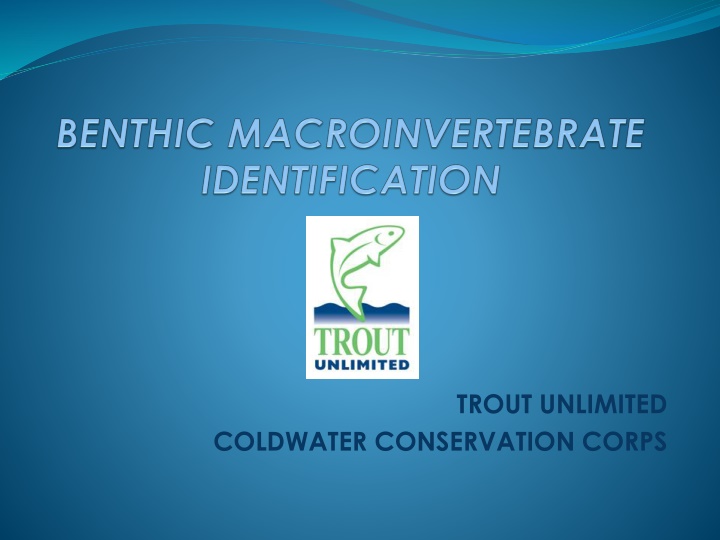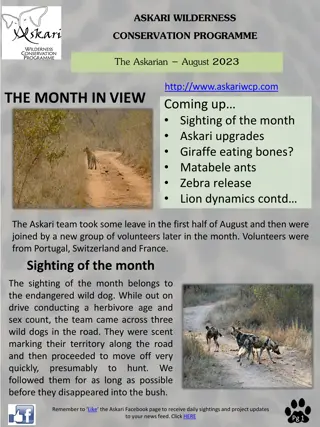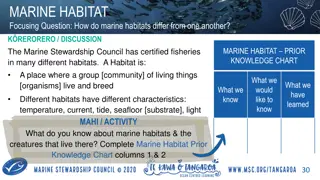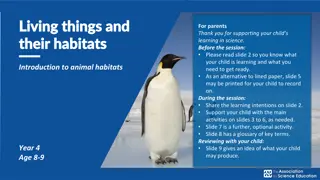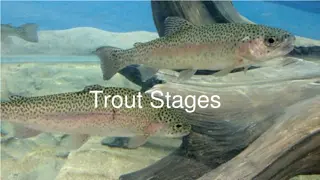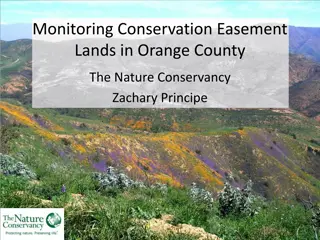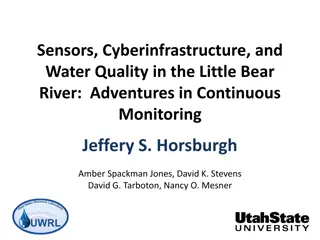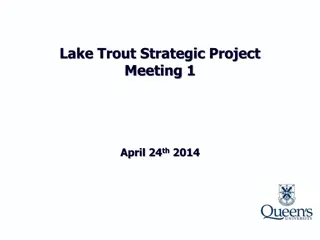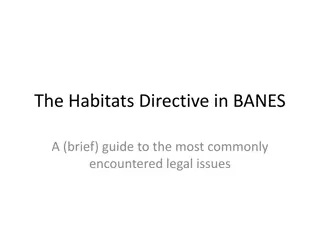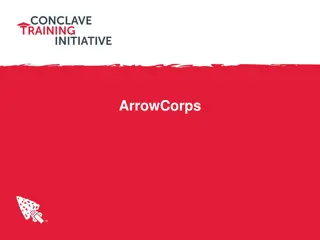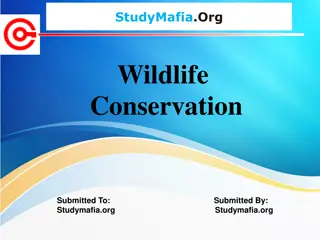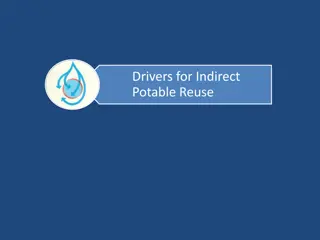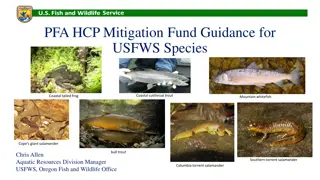Coldwater Conservation Techniques for Monitoring Water Quality in Trout Habitats
Learn about the Trout Unlimited Coldwater Conservation Corps' process for assessing water quality in trout habitats, including sampling techniques, taxonomic sequencing, and categorizing pollution tolerance levels of aquatic macroinvertebrates. Discover pollution-sensitive, somewhat sensitive, and pollution-tolerant taxa commonly found in these habitats.
Uploaded on Sep 16, 2024 | 1 Views
Download Presentation

Please find below an Image/Link to download the presentation.
The content on the website is provided AS IS for your information and personal use only. It may not be sold, licensed, or shared on other websites without obtaining consent from the author.If you encounter any issues during the download, it is possible that the publisher has removed the file from their server.
You are allowed to download the files provided on this website for personal or commercial use, subject to the condition that they are used lawfully. All files are the property of their respective owners.
The content on the website is provided AS IS for your information and personal use only. It may not be sold, licensed, or shared on other websites without obtaining consent from the author.
E N D
Presentation Transcript
TROUT UNLIMITED COLDWATER CONSERVATION CORPS
THE CCC BMI PROCESS 1. Select sampling site and specific locations. 2. Obtain sample(s). 3. Sort and identify critters to Order (Family, in a few cases). 4. Count number of organisms in each Order and enter data in the CCC Macroinvertebrate Count Data Sheet. 5. Enter group data into the water quality rating algorithm and compute water quality rating (i.e., biological index).
TAXONOMIC SEQUENCE Example Animalia Arthropoda Insecta Plecoptera (Stoneflies) Capniidae (Winter Stoneflies) Capnia vernalis (Early Black Stonefly) Kingdom Phylum Class Order Family Genus Species
POLLUTION TOLERANCE We will group our critters into three categories of pollution tolerance. Sensitive to pollution Somewhat sensitive Pollution tolerant
POLLUTION SENSITIVE TAXA Stonefly Nymphs [Order Plecoptera] Mayfly Nymphs [Order Ephemeroptera] Non-Net Spinning Caddisfly Larvae (case builders) [Order Tricoptera] and Free-living Caddisly Larvae Hellgrammites (Dobsonfly Larvae) [Order Megaloptera] Water Pennies (a beetle larva) [Order Coleoptera] Riffle Beetle Adults [Order Coleoptera] Gilled Snails [Class Gastropoda]
SOMEWHAT SENSITIVE TAXA Cranefly Larvae [Order Diptera Family Tipulidae] Net-Spinning Caddisfly Larvae [Order Tricoptera Families Hydropsychidae, Philopotamidae, Polycentropodidae] Dragonfly Nymphs [Order Odonata] Damselfly Nymphs [Order Odonata] Scuds [Order Amphipoda] Sowbugs [Order Isopoda]
SOMEWHAT SENSITIVE TAXA (cont.) Beetle Larvae [Order Coeoptera] Fishfly Larvae [Order Megaloptera Family Corydalidae] Alderfly Larvae [Order Megaloptera Family Sialidae] Crayfish [Order Decapoda] Clams [Class Pelecypoda]
POLLUTION TOLERANT TAXA Midge Larvae [Order Diptera Family Chironomidae] Blackfly Larvae [Order Diptera Family Simulidae] Aquatic Worms [Class Oligochaeta] Leeches [Order Hirudinea] Other Snails [Class Gastropoda]
Identification Notes Aquatic Insect Body Plan Head Thorax Abdomen Thoracic segments 3 Legs 3 pairs (on thoracic segments) Abdominal segments - variable
Identification Notes Mayflies (Ephemeroptera) S Cylindrical to flattened form Slender antennae Platelike or feathery gills on abdomen Single tarsal claw at end of middle and hind legs Most species have three tails, but some have only two.
S Identification Notes Stoneflies (Plecoptera) Long, slender antennae Wing cases prominent on thorax Gills on thorax Two tails
SS Identification Notes Cranefly Larvae (Tipulidae) Wormlike; segmented No legs Tentacles or fleshy lobes at tip of abdomen Head usually with- drawn into thorax; they often appear headless
Identification Notes Blackfly Larvae (Simuliidae) T Single proleg located ventrally behind head Posterior of abdomen enlarged body appears club-shaped Gills at posterior end of body
Identification Notes Midge Larvae (Chironomidae) T Small; segmented; usually red or greenish Well-defined head Paired prolegs immediately behind the head Paired prolegs on terminal segment; also (usually) short projections w/tufts of hairs
SS Identification Notes Dragonfly Nymphs (Odonata) Large eyes Wicked mandibles (jaws) Wide abdomen Breathe thru their anus!
SS Identification Notes Damselfly Nymphs (Odonata) Elongate, slender form Two sets of wing pads Three feathery gills on end of abdomen
SS Identification Notes Scuds (Class Amphipoda) Look like little shrimp Body flattened from side to side Two pairs of long antennae Seven pairs of legs
SS Identification Notes Sow Bugs (Class Isopoda) Segmented body; last segment larger than the rest Two pairs of antennae one short, one long Seven pairs of legs last pair look like flattened tails
S Identification Notes Water Penny (Coleoptera) Larvae are flattened and disclike. Easily recognized Found attached to rocks
S Identification Notes Riffle Beetles (Coleoptera) Smaller than most other beetles Antennae usually slender, but sometimes clubbed Claws at ends of legs
S Identification Notes Dobsonfly Larva (Megaloptera) Large critters; 1 to 6.5 inches Filaments on each abdominal segment Two anal prolegs with hooks Well developed chewing mouthparts (see next slide) Legs Filament
SS Identification Notes Dobsonfly Larva (Megaloptera)
SS Identification Notes Fishfly Larva (Megaloptera) Smaller than dobson- fly (hellarammite) larva; to 1 inch. Reddish-tan; sometimes with yellow streaks Filaments on abdominal segments Two anal prolegs with hooks
SS Identification Notes Alderfly Larva (Megaloptera) Smaller than dobson- fly (hellagrammite) larva; to 1 inch. Lateral filaments on abdomen have 4-5 segments. A single terminal filament
Caddisflies (Trichoptera) A large group of aquatic insects over 1,200 species Larvae are often a large and important component of benthic communities Sensitive: a number of families of case-building caddisflies and the free-living caddisflies of Family Rhyacophilidae Somewhat sensitive: the net-spinning caddisflies of Families Hydropsychidae, Philopotamidae, and Polycentropodidae
S Identification Notes Caddisflies - Rhyacophilidae Free-living; do not build cases or spin net for feeding A single dorsal plate behind the head (1st thoracic segment) Two prolegs with single claws on last (9th) abdominal segment.
S Identification Notes Caddisflies - Rhyacophilidae Green rock worm (Genus Rhyacophila) Note single dorsal plate on first thoracic segment and anal prolegs
S Identification Notes Caddisflies Case Builders
S Identification Notes Caddisflies Case Builders
SS Identification Notes Caddisflies - Hydropsychidae Body typically curved Dorsal plates on all three thoracic segments Anal prolegs usually have a tuft of long hairs.
SS Identification Notes Caddisflies - Philopotamidae Body typically curved Dorsal plate on only the first thoracic segment No gills on abdomen Labrum (upper lip) modified to form a scraper.
SS Identification Notes Caddisflies - Polycentropodidae Dorsal plate on only the first thoracic segment. Abdominal segments with some short hairs, but no gills Trochantin (shoulder blade) sharply pointed.
S Identification Notes Gilled Snails (Gastropoda) Spiral shaped Opening is on the right A thin horny plate (the operculum) covers the opening when the foot is retracted
T Identification Notes Other Snails (Gastropoda) Can be spiral shaped or coiled Do not have an operculum If spiral shaped, opening is on the left
SS Identification Notes Beetle Larvae (Coleoptera) Distinct head with chewing mouthparts Thoracic legs usually present Eight to 10 abdominal segments Never have terminal prolegs
SS Identification Notes Beetle Larvae (Coleoptera)
S Identification Notes Beetle Larvae (Coleoptera) SS
Useful References How to Know the Aquatic Insects (Spiral-bound) by Dennis M. Lehmkuhl Good drawings and identification keys to Order, and in some cases Family. Available used (good or very good condition) via Amazon.com for under $20 ($61 new). A Guide to Common Freshwater Invertebrates of North America by J. Reese Voshell, Jr. Available new via Amazon.com (~$25); also available used
Useful References Aquatic Entomology The Fishermen s and Ecologists Guide to Insects and Their Relatives by W. Patrick McCafferty Available new and used via Amazon.com (variable pricing)
Helpful Web Links Freshwater Macroinvertebrates of New York. http://www.dec.ny.gov/animals/35772.html Bugguide.net. Great photos and information! Can search by order, class, etc. http://bugguide.net/node/view/15740 IOWATER Photographic Guide to BMI. Great photos; geared toward volunteers. http://www.iowater.net/Publications/IOWATERB enthicPhotographicGuide.pdf
